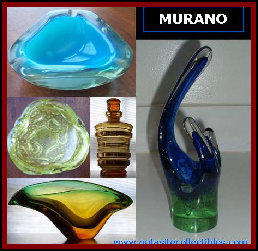














NOVA-Antiques was mentioned by Jura Koncius of the
NOVA-Antiques was selected Website of the Week by Evan Haning and WTOP Radio in
NOVA-Antiques
was designated a resource for antiques flea markets in an article in the Weekend Section of the

Thank you for your continued support and readership. Please insure to forward this Newsletter to your friends and neighbors. If you no longer wish to receive our emails regarding the update of this page, please send us an email to info@nova-antiques.com with the subject line "OPT OUT"
NOVA-Antiques.com does not run, manage or operate any of the flea markets, auction houses or estate sale companies advertised on this page. The NOVA-Antiques Newsletter is published for the exclusive use, enjoyment and convenience of our readers and subscribers. Any questions regarding the flea markets, auction houses and estate sale companies should be directed to the appropriate owner, promoter or manager.

A Brief History of Murano Glass
Glass is nothing more than sand which is usually mixed with an alkaline flux to make it easier
to melt at lower temperatures. Since glass can break down over time, depending on quality, a stabilizer, normally lime, is used
to make it last longer. Most glass with no other additives is a greenish color. However since ancient times, glass makers
have been adding different metals and oxides including gold to change the color of glass. Some of the most prominent and beautiful
colored glass is produced by the Venetians and more specifically the island of Murano.
In the 11th Century, glass making in Venice was regulated and the importation of glass was against the law. Additionally foreign
glass makers were not allowed to operate in the city. In the late 1200’s, because people were afraid that all the furnaces operating
in Venice may someday catch the city on fire, a law was passed that banished all glassmaking to the island of Murano. And another
law made it illegal for Venetian glass makers to immigrate out of the country. It wasn’t until the 1400’s that glassmakers from
other countries and influences from different cultures were allowed onto Murano.
As a result of influences from the Middle East and the Far East, Murano glass which was already delicate and beautiful, became even
more stunning. The Venetians were already making colorful glass in many shapes; the Middle East influence gave them the ability
to produce enameled glass. In the 1600’s, an artisan named Angelo Barovier, whose glass today is still much sought after, introduced
the world to crystal, which was a very clear and flawless glass and much like today was used to produce high quality items for the
well to do. However, all of the items made were copied and unoriginal pieces and it wasn’t until much later that art glass came
to be.
Art glass which was original and unique came in many different shapes and sizes, but did not become popular until much
later. Besides Barovier, many of today Murano glass collectors seek out art glass by other art glass houses including Toso,
Cenedese, Barbini and probably the most collectible glass comes from Venini. Some of the most sought after pieces are mid-century
modern art glass with smooth lines and controlled bubbles as well as colorful designs that include aventurine, gold fleck and millifiore. If you were to visit Murano today, you would find most of these art glass manufacturers still plying their trade after hundreds of
years.
Collecting Venini Art Glass from Murano
Although many of the art glass manufacturers on the island of Murano have been around
for hundreds of years, one stands out among others and it has only been around since 1921, Venini. Started by an attorney named
Paolo Venini along with an antiques dealer, Giacomo Cappellin, Venini Glass quickly became one of the leading producers of cutting
edge, tastefully decorated and artistically pleasing art glass. Arguably, their success can be attributed to the hiring of great
artistic glass blowers and talented designers that included names such as Andrea Rioda, Ettore Stottsass and Fulvio Bianconi. And these are just some of the names that Murano Glass collectors look for today.
The best place to start a Venini art glass collection is with some research. Keep in mind that there are thousands of Murano
art glass pieces and a lot of them look very similar, so you have to familiarize yourself with the shapes and sizes of Venini. Secondly, you have to make a decision as to what type of art glass to collect. Although, bowls and ashtrays are probably abundant
and can be easily found, you may want to instead collect the colorful vases, paperweights or art glass figurines. Beware of
fakes. Many art glass manufacturers who are not remotely associated with Venini or even the island of Murano will try to sell
glass that is marked “Murano Style.” If you can afford it, buy the best possible pieces because they are more likely to
appreciate in value.